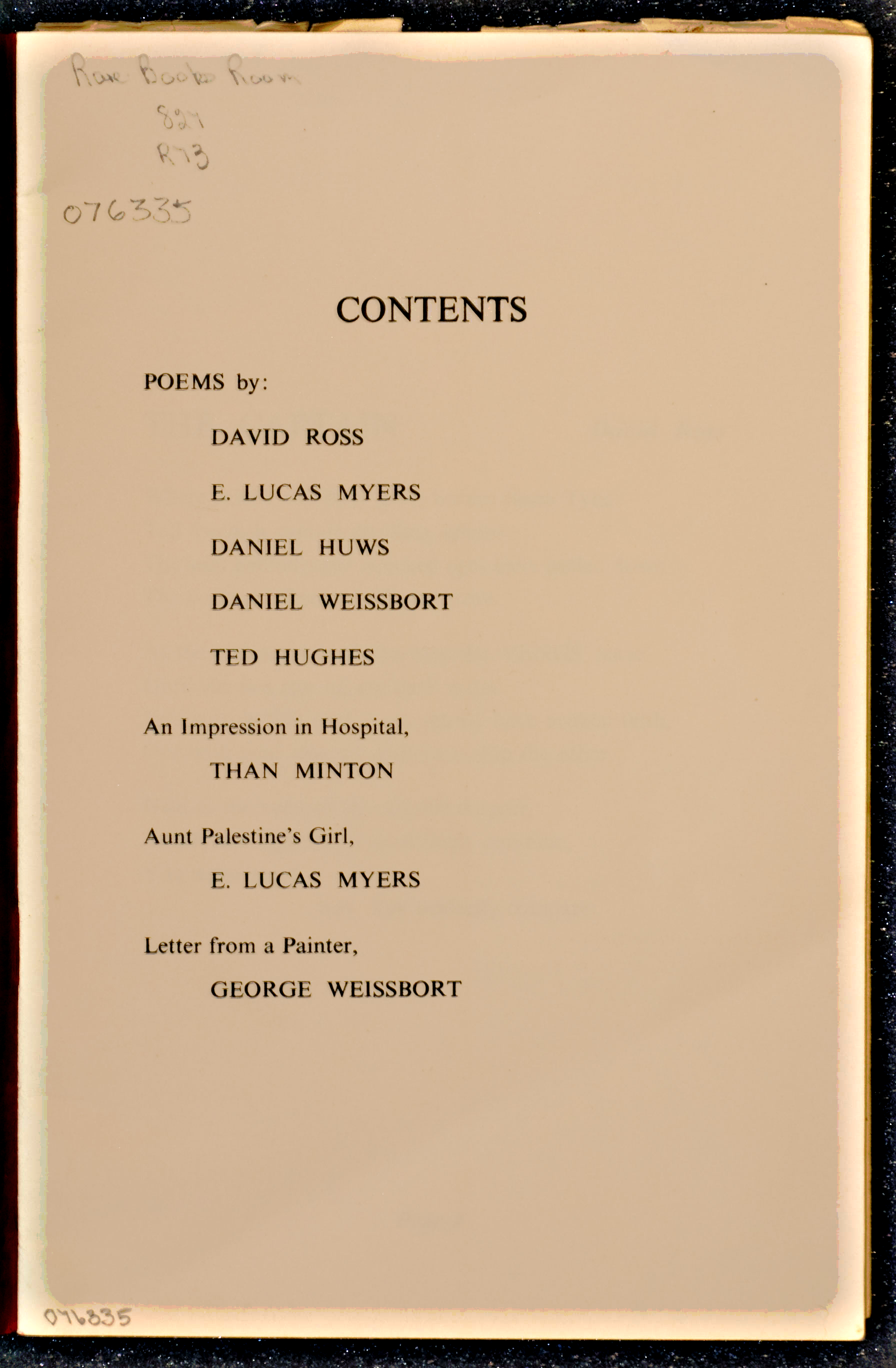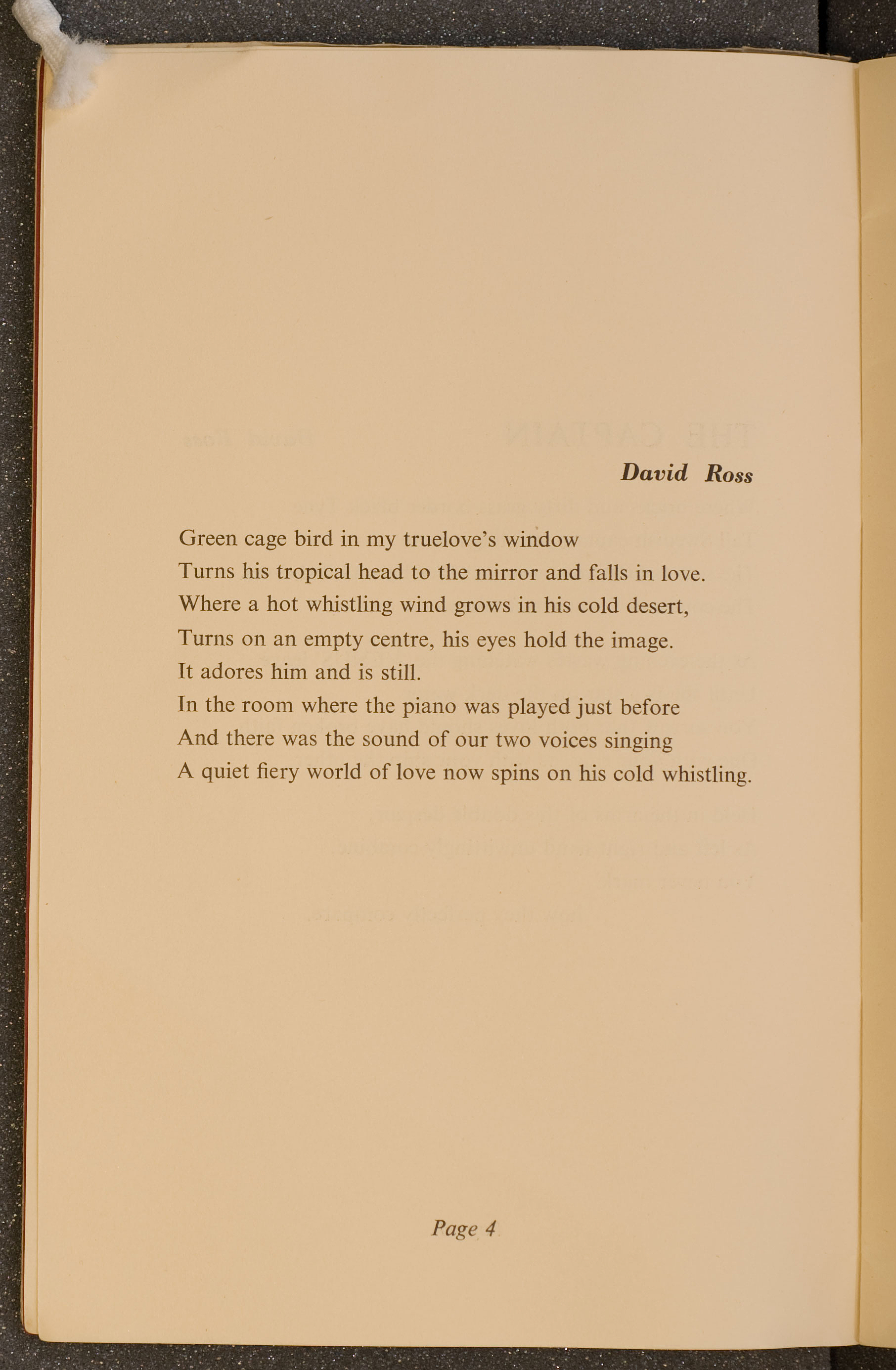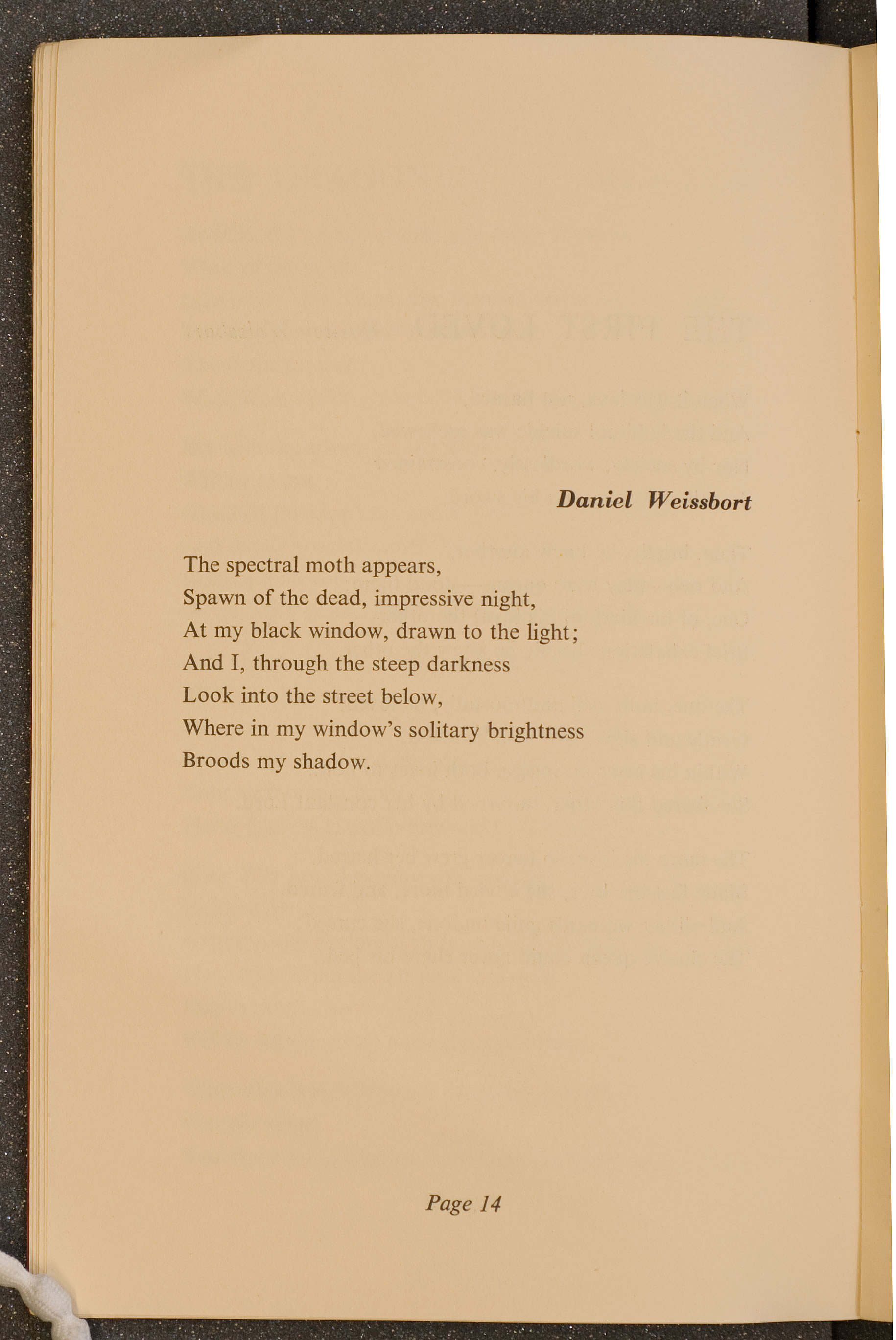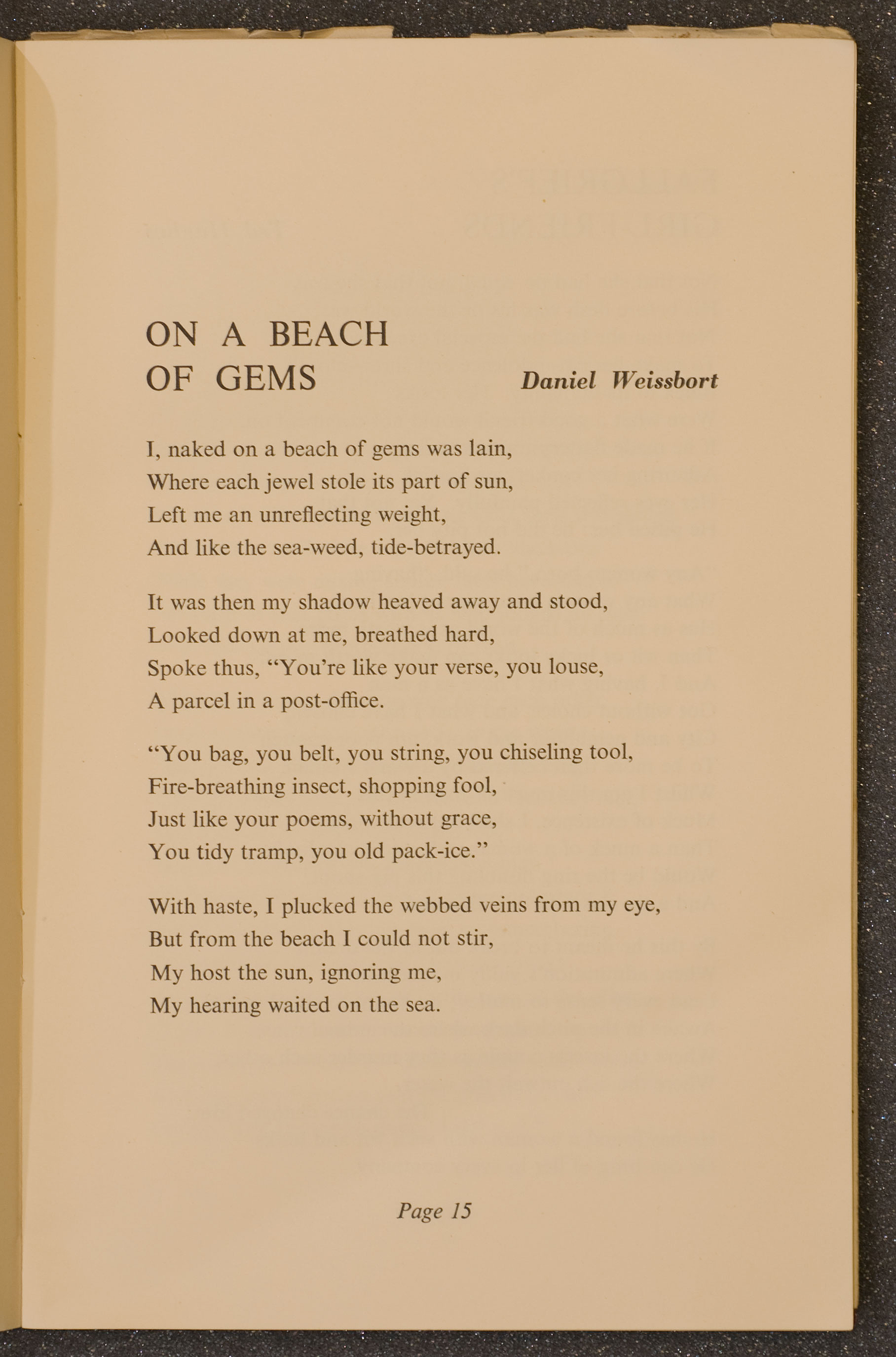Hughes’ Student Writing: St Botolph’s Review
Ted Hughes began to write while still a student, and like many student poets he had his work included in short-lived publications. One of these - Saint Botolph's Review (1956), edited by David Ross and Daniel Weissbort - has special importance. Adam Crothers has written a short introduction explaining its significance. Unfortunately, for copyright reasons, we cannot include images of the poems themselves, but we can include the cover and the contents page, to give you some flavour of what one surviving copy of the review looks like now. We have also included a much more recent student poetry publication, the Dial. The relationship between studying literature and writing it is not a straightforward one, but most of the Cambridge Authors, like many current students, made significant creative steps while at University.
St Botolph's Review
Although he wrote poems as an undergraduate, and published a number of them both pseudonymously and under his own name, the most important of Ted Hughes's publications in Cambridge came about after he had graduated. Hughes's friend Lucas Myers spent some time living at the rectory of Saint Botolph's Church, and the magazine that they and a few companions launched on 26th February 1956 bore the name Saint Botolph's Review. It was at the launch party that Hughes and Sylvia Plath met, although in an important sense they had met already: her poems had already appeared in a number of Cambridge publications, and she was familiar enough with her advance copy of Saint Botolph's to quote Hughes's own verse at him that night as they danced.
The second issue of the magazine, still under the editorship of David Ross, appeared in 2006. It contained work by some of the original contributors, including an introduction written by Hughes decades earlier to the poems of the late Susan Alliston, his London neighbour (mentioned in the Birthday Letters poem '18 Rugby Street'). Ignoring the chain of events the magazine would ignite in the lives of Hughes and Plath, it remains impressive that a magazine whose second issue took fifty years to appear, and whose first issue's contributors were then admired only within their social circles, should be thought of as something other than a mere curiosity. It helps that Hughes was not the only one who went on to success as a writer: Lucas Myers and Daniel Weissbort, in particular, are well known for poetry and prose writing.
The subsequent success of poets who published work when at Cambridge inevitably leads one to think of any new student publication as the home of at least one 'next big thing', or whatever the equivalent in the poetry world might be. But it is important also to remember that no writer has the benefit of hindsight when embarking upon her or his career: one can, and should, admire potential, and praise the poem as an indication of what the poet might one day be, but some admiration must also be given to the poem as it stands. In other words, while there is room to consider Hughes's early work as a preface to his more acclaimed poetry, it would be wrong to deny this early writing the acclaim that it earns for itself.
St Botolph's Review
By clicking below you can see the front and back covers, and the contents page, of St Botolph's Review, along with a selection of pages. The copy we used is in Girton College Library, and is reproduced with Girton's permission. The photographs were taken by members of the Scriptorium project - for more details see the Acknowledgements page. We are grateful for the help given by David Ross and Daniel Weissbort themselves as we prepared this page.
The Hughes poems we aren't able to reproduce are: 'Secretary', 'Soliloquy of a Misanthrope', 'Fallgrief's Girlfriends', 'Meeting', and 'Law in the Country of Cats'. Since they are all in The Hawk in the Rain, his first published volume, and then in later collections of his work, they are not hard to track down. This might give you some flavour of the publication.
For another St Botolph experience, watch the first few minutes of the movie Sylvia (2003), starring Daniel Craig and Gwyneth Paltrow. (It probably isn't supposed to be on Youtube, but at the time of writing, it is.) You'll see the Review, Sylvia reading it, and their first meeting.
The Dial
One of the most interesting things about the first issue of St Botolph's Review is the way in which this material book, of limited circulation, passed from and through the hands of other key friends and writers in Hughes' circle -- not only the friends who first published and read him, but Sylvia Plath, whose life and writings were to be so closely associated with Hughes' own. Student literary magazines, like the universities in which they are conceived, written, and consumed, are in part defined by their social and communal dynamics. Encountering literary writing in this format emphasises its social character in a way that the single-author collection, or the course-based syllabus in which many people read poetry, does not. Many famous and canonical English writers had their start, like Hughes, in university writing communities: the Elizabethan poets Edmund Spenser and Christopher Marlowe, for example, both began writing among friends while studying at Cambridge, John Donne circulated his lyrics and satires in the Inns of Court in London, and Tennyson (as Emma Leadbetter shows in an article for Cambridge Authors) used his university years to improve his writing within the comfort of a tight circle of like-minded (and talented) friends.
This sociality of literary writing persists in modern universities, of course. Much of the best (or most successful, or most capitalised) English literary art of the next century, like that of the past century, will be birthed and fledged in university writing communities across the world. Cambridge continues to play its part in this lively play of ideas, voices, experiments, and ephemera. As a way of witnessing and thinking about this sociality of literary endeavour in action, consider the recent revival of another Cambridge literary magazine, the Queens'-based Dial. This publication brings together the literary and design efforts of a loose group of friends and acquaintances, whose writings rub shoulders with one another here, for the first time -- but may well go on to other contexts and formats. As you browse the pages below, consider some of the conditions and pressures that affect literary writing in this environment: the novelty of exposure for new writers, the advantages and disadvantages of anonymity (or obscurity), the difficulties and opportunities of being read in a context where readers may know you as well as your words, and so on. When you've finished browsing or reading from the Dial, try thinking further about some of these issues with the questions at the bottom of the page.
[high-resolution file]
Further Thinking
Circulation of poetry or other writing within a writing community can easily lead to immediate personal or social outcomes for the writer; Ted Hughes, for example, earned the interest (perhaps the admiration) of a woman he would shortly marry. Does (or can) this change the nature of the writing itself? Ought we to think differently about poetry or prose written 'for' a select and intimate audience, compared to writing produced for a public audience, or even for posterity? What about writers who write for no audience at all? ('Found' poetry?)
One of the interesting things about leafing through an old magazine like St Botolph's Review is the experience of confronting the poetry of an acknowledged literary celebrity -- here, Ted Hughes -- in a publication produced before that celebrity was acquired. It may be impossible fully to discern the quality of a poem behind the celebrity (or in some cases infamy) attaching to a celebrated writer like Hughes, but this experience provokes us to try. Do you find yourself unsettled by this process? How many of your own preferences and critical judgments are informed by convention (or resistance to convention), by the influence of others' opinions, or by the conditions created by publishers, bookshops, and/or libraries?





